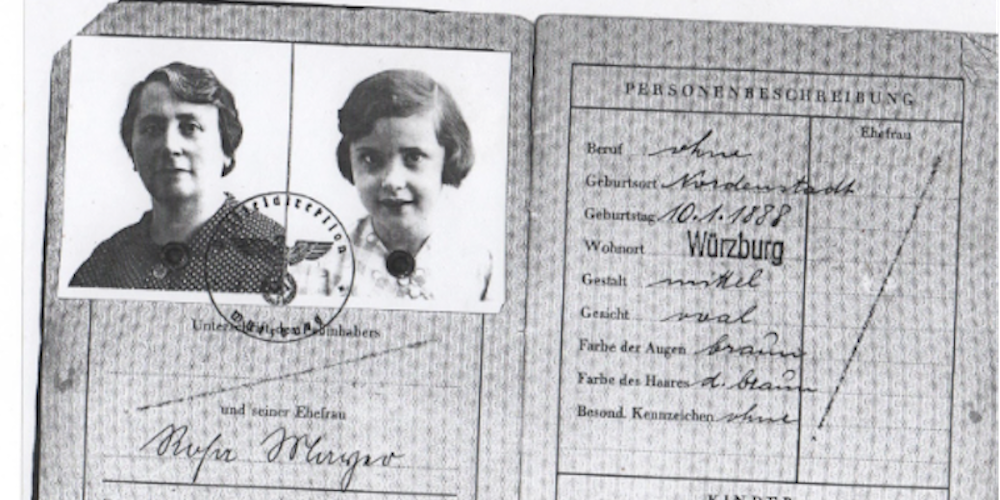Forging Diplomatic Connections Through Storytelling
Having fled Nazi Germany, my grandmother implored me to get involved in public service and help build a better world.
By LAUREN PROTENTIS | MAY 15, 2022

I was only 5 years old when my grandmother, Inga Protentis — or Oma to me — first told me about the horrors she and her Jewish family lived through in her native Germany during the Holocaust. Her father, Max Mayer, one of Hitler’s early critics, was sent to the Dachau concentration camp soon after the Nazi takeover — Inga was barely a year old. In 1939, shortly before Inga turned 7, she and her mother, Rosa, fled to the United States.
Every time Oma told me a story from her childhood, she implored me to get involved in public service and do my best to create conditions that don’t allow for another Holocaust to happen. As a young adult, I struggled to find answers to questions that millions before me had asked: Why did the Nazis hate Jews, and why did no one stop them? I attended services at Oma’s synagogue after it was severely vandalized, just a half-mile from her home in Massachusetts. After Hurricane Katrina in 2005, I volunteered in disaster-relief for AmeriCorps.
My public service career began in 2012 in public diplomacy for the U.S. Department of State, where I first became aware of storytelling as a form of diplomacy. While facilitating sessions of the department’s flagship professional exchange, the International Visitors Leadership Program (IVLP), I noticed that participants introduced themselves not just with their names, but with their stories. It was a way to get to know each other quickly, identify common interests, experiences and values, and build meaningful connections. Such shared storytelling led to ideas about how to tackle longstanding challenges, such as fighting corruption in Lebanon, resolving the Israeli-Palestinian conflict and improving women’s rights in Afghanistan. This form of communication broke down barriers and fostered empathy.
So I started introducing myself not just with my name and title, but through my story: I came to public diplomacy in an effort to answer my Oma’s call to help foster mutual understanding and overcome differences. Many IVLP participants were also motivated by conflict and strife, which some had experienced firsthand. One of the programs I managed was for Egyptian entrepreneurs who, in the aftermath of the 2011 Arab Spring, were trying to come up with creative solutions to the country’s staggering unemployment problem. Another program included Israeli parliamentarians, who got to meet Oma. My experience of inadvertently becoming a bystander to the Egyptian revolution and the 2006 Israeli-Hezbollah war forged immediate connections.
From exchange programs, I moved to the State Department’s Global Engagement Center, which uses communication tools to counter foreign disinformation and propaganda. In 2015, our top priority was combating the so-called Islamic State’s recruitment and radicalization efforts online. Our approach was to use storytelling, rather than traditional policy-focused messaging, to reach young people and educate them about the terrorist group’s true nature. Two colleagues and I met with civil-society organizations and families of foreign fighters. One mother told us the emotional story of her son’s radicalization and eventual mobilization to become a fighter for a terrorist group. She recounted the slow process of the radicalization, the associated signs and her lingering feelings of loss, shame and regret. She also spoke about her son’s mental health and social anxiety, and the respite he found in a new religion.
After speaking with dozens of family members of foreign fighters, we created a global network of parents and organizations, which put human stories at the center of the U.S. government’s efforts. It helped parents recognize radicalization signs and made children aware that what they heard from recruiters was propaganda. In just 10 months, the network gained more than 75 group members from 20 countries, with our online campaign reaching millions of people in five languages across social and traditional media. Everyone on our team was female and came from historically marginalized communities, including a Palestinian-American and a Black American.
In 2018, the State Department loaned me to the British Foreign Office’s Global Coalition Communications Cell to work on countering disinformation with our strongest ally. Despite significant differences in organizational and bureaucratic systems and culture, we found common cause in addressing daunting challenges that required creative and coordinated solutions.
Last year, I moved to the Department of Homeland Security, where I work on a task force countering foreign influence in the United States. I continue to tell Oma’s stories as a potential pathway to peace and coalition-building.
One of the most touching stories is about a Nazi soldier who likely saved the lives of Oma and her mother. After her father was sent to Dachau, her mother sheltered other Jewish families in their large house. One night, Nazi storm troopers broke in and arrested everyone they found — except for Inga and Rosa, who hid in a distant room and mounted heavy furniture against the door. The Nazis came close, but of them suddenly declared that no one else was left in the building. That soldier knew the Mayer family and used to frequent their bakery as a student. In fact, he had been one of many poor youngsters Max used to feed for free, asking that they pay him back when they made it in life.
One might question whether that soldier really made it. But pay back he did. As for Max, he was transferred from Dachau to Buchenwald, from where he escaped, and eventually made his way to the United States.
Lauren Protentis is a team lead on the Countering Foreign Influence Taskforce at the Department of Homeland Security and former director of the State Department’s Global Engagement Center.
The views and characterizations in this article belong to the author and don’t necessarily represent those of the U.S. government.

